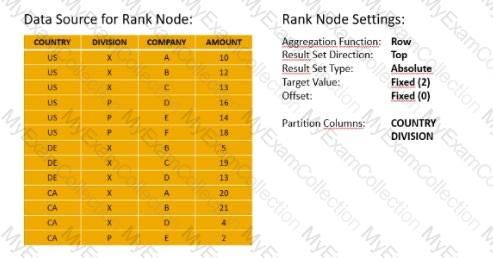You want to join two tables in a calculation view.Why do you use a non-equi join?
Why would you set the "Ignore multiple outputs for filters" property in a calculation view?
In Business Application Studio, you rename a DIMENSION calculation view that is used by a CUBE calculation view. You do NOT use the option to rename the runtime view and adjust the reference. Afterward, you perform the following deploy operations:Deploy the DIMENSION calculation view as a single object.Deploy the entire SAP HANA database module.What is the outcome of the deploy operations?
In SAP HANA Cloud, which tasks are handled by the cloud provider?Note: There are 3 correct answers to this question.Sizing, provisioning, and monitoring the database
A calculation view includes a rank node that uses the source data and settings shown in the graphic.

Your query requests all columns of the rank node.How many rows are in the output of your query?
You have imported a new calculation view in a folder that contains an .hdinamespace file. This calculation view consumes one data source, which is a table. When trying to deploy the calculation view, the deployment fails with a namespace-related issue.What could be the reason?Note: There are 2 correct answers to this question.
What is the SQL keyword used to process input parameters defined in a calculation view?
You want to ensure that your calculation view does not give unexpected results for a query that is based on any combination of columns.What is the recommended approach for verifying the results?
What are some of the restrictions that apply when defining parallelization blocks in calculation views? Note: There are 2 correct answers to this question.
What is generated when you deploy a CUBE calculation view design-time file?Note: There are 2 correct answers to this question.
You deleted the design-time file of a calculation view in your HDB module.What is the recommended way to ensure that the corresponding runtime object is also removed from the database?
In your calculation view, you want to consume a custom data source defined using SQLScript.In which type of object do you write your code?
What are some best practices for writing SQLScript for use with calculation views? Note: There are 2 correct answers to this question.
You have generated a calculation view properties file.What does it contain?
What options do you have to handle orphan nodes in your hierarchy?Note: There are 2 correct answers to this question.
In a calculated column, which object do you use to process a dynamic value in an expression?
Why would you partition a table in an SAP HANA Cloud database? Note: There are 2 correct answers to this question.
A new version of SAP HANA Cloud, SAP HANA database is available from today.If you do not perform the upgrade manually, how much time do you have before your database will be automatically upgraded to the next version?
Why does SAP issue warnings about the use of imperative or procedural SQLScript statements?
You have configured static cache for your calculation view and run a query against it, but the cache results are not being used.What might be the reason for this?

